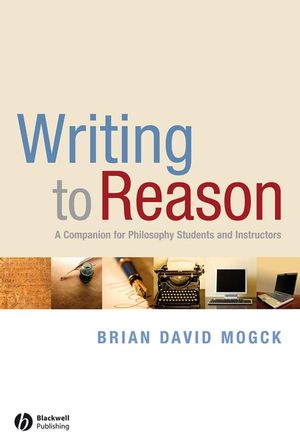|
Textbook
Writing To Reason: A Companion for Philosophy Students and InstructorsISBN: 978-1-4051-7099-4
Paperback
158 pages
March 2008, ©2008, Wiley-Blackwell
 This is a Print-on-Demand title. It will be printed specifically to fill your order. Please allow an additional 10-15 days delivery time. The book is not returnable.
|
||||||
Preface: A Users’ Guide ix
P.1 A Note to Instructors ix
P.2 A Note to Students xii
Acknowledgments xviii
Glossary of Philosophical Terms xix
Part I: Writing Philosophy 1
1 Writing a Philosophy Paper 3
1.1 What is a Philosophy Paper Supposed to Accomplish? 3
1.2 Choosing a Topic 4
1.3 Moving through Drafts 11
1.4 The Only Outline You Need is a Sketch of the Argument You Plan to Make 12
1.5 The Cardinal Virtues: Logical Rigor and Clarity of Expression 13
1.6 A Checklist for Spotting Problems Early 14
2 Philosophical Writing Advances a Thesis with an Argument 16
2.1 Consuming Arguments 16
1 What is an argument? 16
2 How is a philosopher’s argument to be recognized? 21
3 The principle of charity 23
4 How is an argument to be criticized? 25
2.2 Producing Arguments 28
5 A clearly stated, tightly focused thesis is essential 28
6 The introduction states why you wrote the paper and why your audience should read it 29
7 The body of your paper follows a strategy to demonstrate your thesis 30
8 Consider objections to your view 32
9 The conclusion of your paper explains the conclusion of your argument 34
10 On words that indicate conclusions and premises 35
11 Provide justifi cation for every important claim 35
12 What makes an argument philosophically interesting? 36
3 The Rudiments of Academic Writing 40
3.1 Elements of Style 40
13 Use the fi rst-person, active voice 40
14 Avoid using a conversational tone 41
15 The paper should have a title 41
16 Pages should be numbered 42
17 The correct use of punctuation 42
18 The correct use of Latin abbreviations 43
19 The correct use of Latin expressions 44
20 The consistent use of pronouns 47
21 Grammatical errors 47
22 Using a term vs. mentioning it 48
23 How to edit or add text within a quotation 49
3.2 Elements of Substance 50
24 Avoid mere rhetoric: philosophy is not forensics 50
25 Avoid using fi ve-star vocabulary words 52
26 The standard of precision in written discourse 53
27 On expressions such as “It is clear that . . .” 53
28 Use accurate terms having clear referents 54
29 Always look for the contrast term 55
30 Watch out for mysterious agents 55
3.3 Substantive Advice 55
31 Never quote the instructor 55
32 Never quote the dictionary 56
3.4 A Few Frequently Misused Terms 56
33 Philosophy vs. view vs. opinion 56
34 Concept vs. conception 57
35 Think vs. feel 58
36 Statement vs. argument 59
37 Sound, valid, and true 59
4 Explaining Philosophical Texts 60
38 Make sense out of the text as a whole 60
39 Make sense out of the main arguments in a text 62
40 Every quotation requires explanation 63
41 Every quotation requires specifi c attribution 64
42 The consistent and meaningful use of technical terminology 66
5 The Rudiments of Academic Research 67
43 Use the library, not the Web 67
44 Primary sources are your primary responsibility 69
45 What kind of secondary sources should be used and how? 70
Part II: Doing Philosophy 73
6 Academic Integrity 75
6.1 Know Your School’s Honor Code and its Policies Regarding Plagiarism 75
6.2 What is Plagiarism? 75
6.3 How to Avoid Plagiarism 76
6.4 Proper Attribution Bolsters One’s Scholarly Credibility 77
6.5 Cheaters are Likely to be Caught 77
7 How to Succeed in a Philosophy Course 79
7.1 Practice the Intellectual Virtues 79
7.2 Come to Class Prepared 82
7.3 Ask Substantive Questions 83
7.4 Respect the Arduous Process of Careful Reading and Writing 83
7.5 Why is Philosophy So Hard to Do? 84
7.6 Why is Philosophy So Hard to Read? 85
7.7 On the Critical Nature of Philosophy and a Few Myths it is Useful to Discard 87
8 What Does it Mean to Do Philosophy? 93
8.1 Philosophers Inquire into Our Concepts and Commitments 94
8.2 Philosophy Explicates What is Implicit in Our Concepts and Commitments 96
8.3 Philosophical Refl ection and the Public Use of Reason 104
Appendix I: Keywords Cross-Referenced to Section Numbers 117
References 119
Index 123



